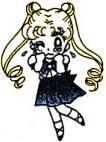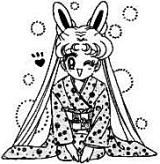
The manga series Bishoujo Senshi Sailormoon deals with the gradual growth of the schoolgirl Usagi Tsukino, who ends up saving the world multiple times. It's a typical "magical girl" shoujo manga, remarkable (to me) for its gorgeous artwork and intricate plot. Would you like a quick and dirty introduction?
 I've provided short, but detailed summaries of each of the 18 manga tankoubon. The ever-so-pretty tankoubon covers used in the summaries were supplied by Manga Style!
I've provided short, but detailed summaries of each of the 18 manga tankoubon. The ever-so-pretty tankoubon covers used in the summaries were supplied by Manga Style!
Here's a rather frivolous study on the evolution of Takeuchi-sensei's beautiful artwork throughout the Sailormoon manga series. Please keep in mind that I do not profess to be either an artist or a professional art critic; these are just my opinions.
If any terms in the anime lingo confuse you, I've put together a little list of definitions that might help.
The manga was created by the artist Naoko Takeuchi. The company Kodansha published it as a monthly serial in the magazine "Nakayoshi," running from February 1992 to March 1997; the TV anime series with the same name was broadcast simultaneously. Little "side stories" were also published in Nakayoshi's "Run-Run" magazine.
 The manga is now available as an 18-volume comic book series, and has also been made into a musical, translated into several different languages, and spawned incredible numbers of toys, games, and other spinoffs. Takeuchi also published six genga (artbooks) of color manga images from the Sailormoon series. The series "Bishoujo Senshi Sailormoon" won the 17th Kodansha Manga Award.
The manga is now available as an 18-volume comic book series, and has also been made into a musical, translated into several different languages, and spawned incredible numbers of toys, games, and other spinoffs. Takeuchi also published six genga (artbooks) of color manga images from the Sailormoon series. The series "Bishoujo Senshi Sailormoon" won the 17th Kodansha Manga Award.
As for the title, "bi" means "pretty" and "shoujo" means "young girl;" "senshi" means "warrior," and "Sailormoon" is the name of the central character. Hence, the direct English translation is "Pretty Girl Soldier Sailormoon;" the rather long title is usually shortened to "Sailormoon" in casual conversation. It's also optional whether you want to refer to it as "Sailormoon" or "Sailor Moon;" both versions are equally valid. (They look the same in Japanese, you see.)
|